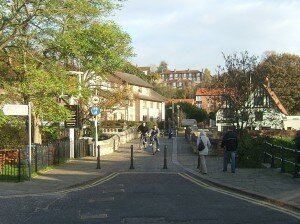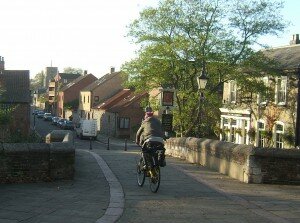Scheme of the Month - Closure of Bishop Bridge, Norwich
 This scheme demonstrates how a simple closure creates a high quality, cost-effective walking and cycling route using existing roads. Although the bridge enhancement works were relatively expensive and protracted (due to the bridge being a scheduled ancient monument) the actual closure costs were relatively inexpensive – the cost of the stopping-up order and the bollards. Signing use and sign size is to a minimum. The issue of ‘substandard’ railing heights (again because the bridge is a scheduled ancient monument) suggests that the current 1.4m height requirement could be reviewed.
This scheme demonstrates how a simple closure creates a high quality, cost-effective walking and cycling route using existing roads. Although the bridge enhancement works were relatively expensive and protracted (due to the bridge being a scheduled ancient monument) the actual closure costs were relatively inexpensive – the cost of the stopping-up order and the bollards. Signing use and sign size is to a minimum. The issue of ‘substandard’ railing heights (again because the bridge is a scheduled ancient monument) suggests that the current 1.4m height requirement could be reviewed.
There was considerable concern about the detour imposed on vehicular traffic and the effect on the adjoining road network. The changes to the road network and traffic patterns, however, quickly settled down. After 10 years it is as if the bridge was always closed to traffic.
Key features of the scheme include:
• Completed in 1998.
• Bishop Bridge provides a crossing of the River Wensum and a route into Norwich city centre from the Inner Ring Road.
• Previously, the route was open to motor vehicles, except HGVs.
 • Bishop Bridge has ‘scheduled ancient monument’ status. It was decided to close it to motor traffic, mainly for structural reasons.
• Bishop Bridge has ‘scheduled ancient monument’ status. It was decided to close it to motor traffic, mainly for structural reasons.
• This closure created an ‘instant’ walking and cycling route.
• Previously, 40% of accidents at this site involved pedestrians and cyclists.
• An existing pedestrian crossing of the Inner Ring Road was relocated and converted into a Toucan.
• Bishop Bridge Road (Inner Ring Road) was narrowed in the vicinity of the crossing to reduce traffic speeds and enhance crossing movements.
• Access to the crossing for pedestrians and cyclists is via a ‘jug-handle’ on the north side of Bishop Bridge Road, a cycle slip on the south side of Bishop Bridge Road, and a kerb build-out with flush kerb for cyclists from Gas Hill (Norwich’s steepest hill!).
• Posts and post and rail were used on approaches to the crossing as an alternative to pedestrian guardrail for aesthetic reasons.
• The bridge parapets, being only 700mm high in places, do not comply with current guidance. The requirement for 1.4m high parapets was never seriously considered since the bridge is a scheduled ancient monument. There have been no accidents involving falls from the bridge in the 10 years since the scheme was completed.
• Approaches to the crossing on the north side are by shared, segregated paths.
• There is no formal segregation over the bridge. However, an informal central ‘carriageway’ with ‘footways’ each side is indicated by flush granite paving strips.
• There is minimal signing and no surface markings.
• Current daily average cycle flow (based on 12 hour counts) is 367
• Accidents involving pedestrians or cyclists have been halved since the scheme went in
For further details contact: Tim Mellors at Norwich City Council:

